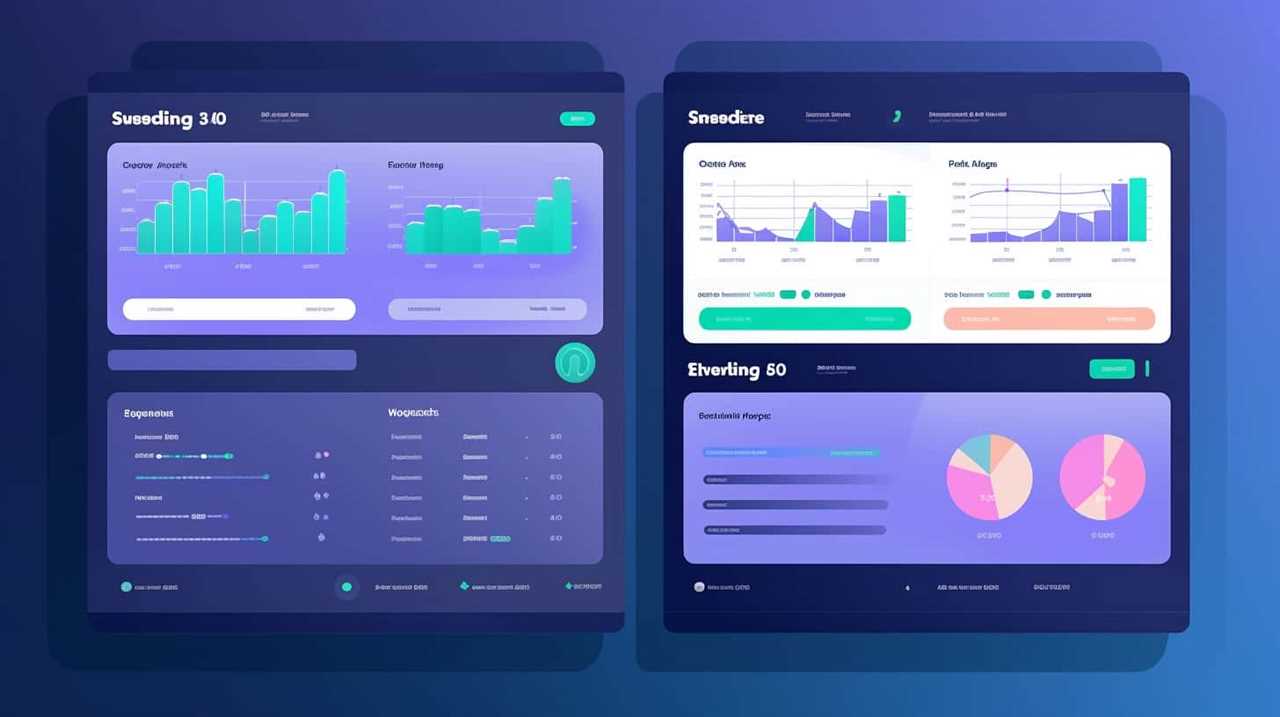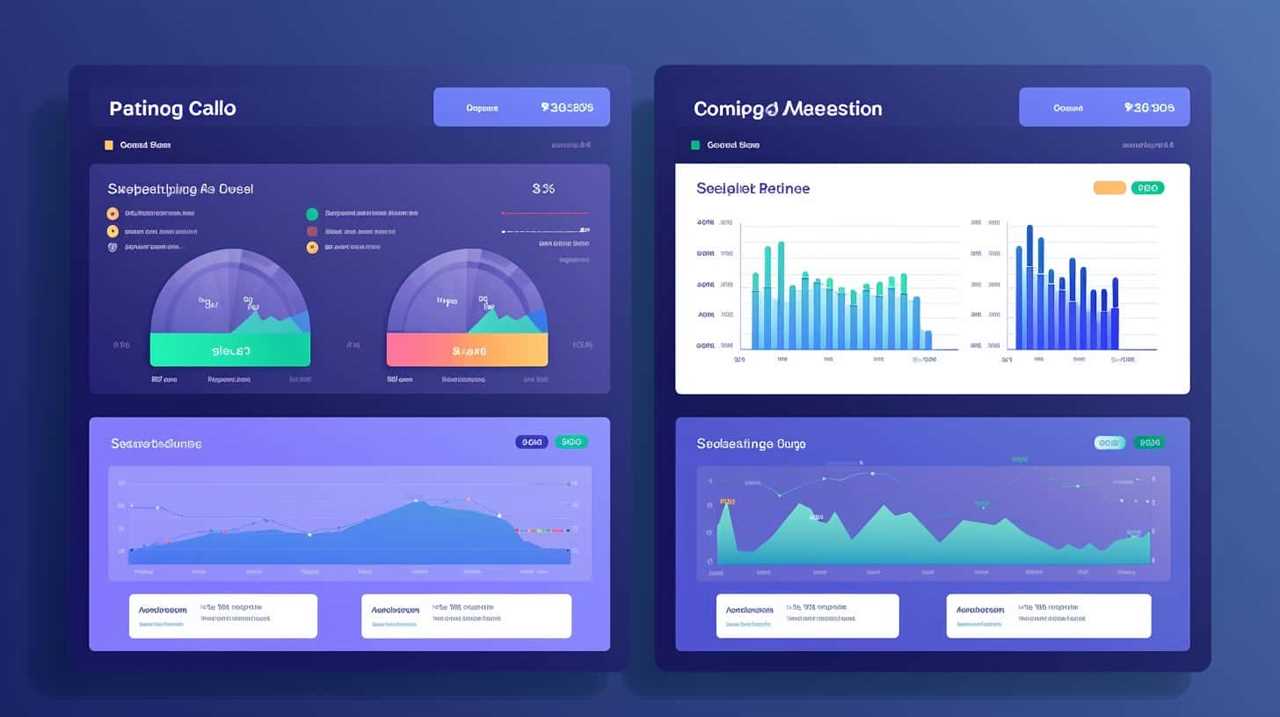As an owner of a VR arcade, I’m well aware of the challenges that come with drawing in patrons and distinguishing our business in a fiercely competitive industry. That’s why I decided to employ Google Ads as a strategy, and the outcomes have genuinely been outstanding.
Did you know that businesses using Google Ads see an average conversion rate increase of 12%?
In this article, I’ll show you how to leverage the power of Google Ads to drive virtual success for your VR arcade business.
Get ready to take your advertising game to the next level!

Key Takeaways
- Google Ads allows for effective targeting and reach of potential customers, leading to increased conversion rates.
- Ad copy should be compelling, visually appealing, and highlight the unique features and benefits of the VR arcade.
- Maximizing the Google Ads budget and using data-driven decision making techniques are key to achieving a high return on investment.
- Retargeting techniques, such as dynamic retargeting and social media retargeting, can increase conversions and drive repeat visits, while local advertising strategies can attract a specific audience in the immediate vicinity of the VR arcade.
Why Google Ads for VR Arcades
I use Google Ads for my VR arcade business because it allows me to effectively reach and target potential customers online. In the competitive world of VR arcades, it’s crucial to employ targeting strategies that maximize the impact of your advertising efforts. With Google Ads, I can refine my targeting by selecting specific demographics, interests, and locations, ensuring that my ads are seen by those who are most likely to be interested in virtual reality experiences.
But it doesn’t stop there. Google Ads also offers powerful ad optimization tools that help me make the most out of my budget. Through continuous monitoring and analysis, I can identify which ads are performing well and adjust them accordingly. This means I can optimize my ad campaigns to drive more traffic to my VR arcade, resulting in increased bookings and revenue.
Furthermore, Google Ads provides valuable insights and data that allow me to make informed decisions about my marketing strategy. By understanding customer behavior and preferences, I can tailor my ads to resonate with my target audience and create compelling campaigns that generate conversions.
In short, Google Ads is an essential tool for any VR arcade business owner looking to maximize their online advertising efforts. With its targeting strategies and ad optimization features, it offers the means to effectively reach and engage potential customers, ultimately leading to increased success in the virtual reality industry.

Targeting Your Ideal Audience
To effectively target my ideal audience, I utilize specific demographics, interests, and locations with Google Ads. By understanding the demographics of my target market, I can tailor my advertising campaigns to reach the right people at the right time. Google Ads allows me to select age, gender, and even household income as targeting options, ensuring that my ads are seen by the audience most likely to be interested in my VR arcade business.
Another key aspect of targeting my ideal audience is focusing on their interests. With Google Ads, I can target users who have shown an interest in virtual reality, gaming, and similar topics. This allows me to reach people who are already interested in the experiences I offer, increasing the likelihood of conversion.
Location targeting is also crucial for improving reach. I can specify the geographic areas where I want my ads to appear, ensuring that I am reaching potential customers in the right locations. Whether it’s targeting a specific city or a radius around my VR arcade, Google Ads allows me to pinpoint my ideal audience with precision.
To summarize, Google Ads provides powerful tools for demographic targeting, interest-based targeting, and location targeting. By utilizing these features, I can effectively reach my ideal audience and maximize the success of my VR arcade business.

| Demographics | Interests |
|---|---|
| Age | Virtual Reality |
| Gender | Gaming |
| Household Income | Technology |
| Location | Entertainment |
Setting Up Your Google Ads Account
To properly set up my Google Ads account, it’s important to understand the key steps and best practices for creating effective campaigns.
One of the first steps is to set up billing. This involves providing payment information and deciding on a budget for your ads. Google Ads offers various billing options, including automatic payments and manual payments. It’s essential to choose the option that works best for your business.
Once the billing is set up, it’s time to explore the ad targeting options. Google Ads provides a range of targeting settings to help you reach your ideal audience. You can target by keywords, demographics, interests, and even specific locations. It’s important to carefully consider your target audience and select the appropriate targeting options to maximize the effectiveness of your ads.
In addition to setting up billing and choosing ad targeting options, it’s crucial to regularly monitor and optimize your campaigns. This involves analyzing the performance of your ads, adjusting bids and budgets, and making any necessary changes to improve your results.

Choosing the Right Keywords for VR Arcades
After setting up my Google Ads account and exploring ad targeting options, I now need to focus on choosing the most effective keywords for my VR arcade business. Keyword research plays a crucial role in ensuring that my ads reach the right audience and generate maximum visibility. By understanding the terms and phrases potential customers are using to search for virtual reality experiences, I can tailor my ads to match their needs and increase the chances of conversion.
To start my keyword research, I’ll use Google’s Keyword Planner tool. This tool provides valuable insights into the popularity and competitiveness of different keywords. I can also discover new keyword ideas and get suggestions based on my business and target audience. By analyzing the search volume and competition level of each keyword, I can prioritize the ones that are most relevant and likely to bring in quality traffic.
Additionally, I’ll consider the intent behind each keyword. Are people searching for VR arcades for entertainment purposes, or are they looking for VR training experiences? By understanding the intent, I can create targeted ads that address the specific needs of my potential customers.
Choosing the right keywords is just the first step in crafting a successful ad campaign. In the next section, I’ll discuss how to create compelling ad copy that grabs attention and entices users to visit my VR arcade.

Creating Compelling Ad Copy
When it comes to creating compelling ad copy for VR arcade businesses, captivating ad language is key.
By using vivid and descriptive words, you can paint a picture of the immersive experience that awaits customers at your arcade.
Additionally, effective call-to-action phrases can motivate potential customers to take the next step and visit your arcade.
Lastly, it’s important to tailor your ads specifically for the VR audience, highlighting the unique features and benefits of virtual reality gaming.

Captivating Ad Language
Crafting captivating ad language is essential for creating compelling ad copy that drives results for VR arcade businesses using Google Ads. By combining compelling ad visuals with persuasive ad messaging, businesses can effectively capture the attention and interest of their target audience.
Here are four key strategies for crafting captivating ad language:
- Use vivid and descriptive language: Paint a vivid picture of the immersive virtual reality experience that awaits customers at your arcade. Use descriptive and sensory words to evoke excitement and curiosity.
- Highlight the unique features: Emphasize the cutting-edge technology, interactive gameplay, and diverse game options available at your VR arcade. Showcase what sets your business apart from competitors.
- Create a sense of urgency: Encourage potential customers to take immediate action by using phrases like ‘Limited time offer’ or ‘Book now to secure your spot.’ This motivates them to act quickly and not miss out.
- Incorporate social proof: Include testimonials or reviews from satisfied customers to build trust and credibility. Let others’ positive experiences speak for your VR arcade’s quality and value.
Crafting captivating ad language is just the first step towards driving results for your VR arcade business. Now, let’s dive into the next section about effective call-to-action phrases.
Effective Call-To-Action Phrases
I will create an effective call-to-action phrase to kick off the discussion on creating compelling ad copy for VR arcade businesses using Google Ads. When it comes to crafting compelling headlines and persuasive language, a strong call-to-action (CTA) is essential. It’s the final push that urges potential customers to take the desired action and engage with your VR arcade business. To help you create an effective CTA, here’s a table that highlights key elements to consider:

| Emotion | Action |
|---|---|
| Excitement | Book Now |
| FOMO (Fear of Missing Out) | Reserve Your Spot |
| Curiosity | Explore VR Today |
Tailoring Ads for VR
To create compelling ad copy for VR arcade businesses using Google Ads, I’ll now discuss how to tailor ads for VR and maximize the impact of your campaign.
When targeting ads for VR, it’s essential to understand the unique characteristics of the virtual reality experience and the interests of your target audience. Here are four strategies to help you create effective ads for your VR arcade:
- Segment your audience: Identify specific groups within your target market and tailor your ads to their interests, such as gamers, tech enthusiasts, or families.
- Highlight the immersive experience: Showcase the unique features of your VR arcade, such as realistic graphics, interactive gameplay, and thrilling adventures, to capture the attention of potential customers.
- Use captivating visuals: Incorporate high-quality images and videos that showcase the excitement and fun of your VR arcade, enticing viewers to visit and experience it firsthand.
- Optimize your ad budget: Continuously monitor and analyze the performance of your ads to ensure you’re allocating your budget effectively. Test different ad formats, placements, and targeting options to maximize your return on investment.
The Power of Ad Extensions
Ad Extensions enhance the effectiveness of Google Ads for VR Arcade businesses. These additional pieces of information can be added to your ads to provide more value and encourage users to take action. There are various types of ad extensions that can be used strategically to maximize the impact of your VR Arcade ads.
One of the key benefits of using ad extensions is that they increase the visibility of your ads. By providing more information and options to users, your ads become more engaging and stand out from the competition. This can lead to higher click-through rates and ultimately, more conversions for your VR Arcade business.

Here is a table showcasing four different ad extension strategies and their benefits:
| Ad Extension Strategy | Benefits |
|---|---|
| Location Extensions | Display your VR Arcade’s address and phone number, making it easy for potential customers to find and contact you. |
| Call Extensions | Allow users to call your VR Arcade directly from the ad, increasing the chances of immediate bookings. |
| Sitelink Extensions | Direct users to specific pages on your website, such as booking or pricing pages, improving user experience and driving conversions. |
| Review Extensions | Showcase positive reviews and ratings from satisfied customers, building trust and credibility for your VR Arcade business. |
Maximizing Your Ad Budget
Maximizing my ad budget is crucial for the success of my VR Arcade business. As a savvy entrepreneur, I understand the importance of getting the highest return on investment (ROI) from my advertising efforts. To achieve this, I employ various ad optimization techniques that help me make the most of my budget.
Here are four strategies that I find particularly effective:
- Keyword Research: I conduct thorough research to identify the keywords that are most relevant to my target audience. By optimizing my ads with these keywords, I can increase the chances of reaching the right people and driving more traffic to my VR Arcade.
- Ad Testing: I constantly test different ad variations to determine which ones perform the best. This includes testing different headlines, ad copy, and calls-to-action. By analyzing the results, I can optimize my ads to maximize their impact.
- Ad Scheduling: I use ad scheduling to ensure that my ads are displayed at the most opportune times. By understanding when my target audience is most active, I can increase the visibility of my ads during those periods and minimize wasted impressions.
- Budget Allocation: I carefully allocate my budget across different campaigns and ad groups based on their performance. By focusing more resources on the campaigns that generate the highest ROI, I can optimize my budget and maximize its impact.
By implementing these ad optimization techniques, I can make the most of my ad budget, increase my ROI, and drive more customers to my VR Arcade business.

In the next section, we’ll explore the importance of tracking and analyzing performance to further enhance our advertising strategies.
Tracking and Analyzing Performance
When it comes to running a successful VR arcade business, tracking and analyzing performance is crucial.
Key Performance Indicators (KPIs) are essential metrics that help me understand how well my marketing efforts are performing.
Key Performance Indicators
To effectively measure and assess the performance of a VR arcade business, I rely on concrete key performance indicators (KPIs). These KPIs help me track and analyze the success of various aspects of the business, ultimately guiding me in making data-driven decisions.

Here are four important KPIs that I focus on:
- Conversion Rate: This metric shows the percentage of visitors who take a desired action, such as booking a VR session. By improving conversion, I can ensure that my marketing efforts are effective and attract customers who are interested in experiencing virtual reality.
- Average Revenue Per User (ARPU): ARPU helps me understand how much revenue each customer generates on average. By increasing ARPU, I can maximize the profitability of my VR arcade business.
- Customer Lifetime Value (CLV): CLV measures the total value a customer brings to the business over their lifetime. By increasing CLV, I can focus on retaining customers and creating loyal, repeat business.
- Return on Investment (ROI): ROI shows the profitability of my marketing campaigns and helps me determine the effectiveness of my advertising efforts. By monitoring ROI, I can adjust my marketing strategies to ensure the best return on investment.
By analyzing these KPIs, I can make data-driven decisions to optimize the performance of my VR arcade business, attract more customers, and ultimately drive growth.
Now, let’s delve into the importance of data-driven decision making.
Data-Driven Decision Making
I rely on data-driven decision making to track and analyze the performance of my VR arcade business. Data analysis plays a crucial role in understanding the trends and patterns that drive customer behavior. By collecting and analyzing data, I can identify the most popular games, peak hours of customer traffic, and customer preferences. This information allows me to make informed decisions about optimizing my VR arcade experience.

Customer segmentation is also a key aspect of data-driven decision making. By segmenting my customer base into different groups based on demographics, behaviors, and preferences, I can tailor my marketing strategies and offerings to better meet their needs. This targeted approach not only improves customer satisfaction but also increases revenue by attracting and retaining loyal customers.
With data as my guide, I’ve the power to make strategic decisions that drive the success of my VR arcade business.
Improving Marketing Strategies
By utilizing data-driven decision making and analyzing performance, I can enhance my marketing strategies for my VR arcade business.
Improving customer experience is crucial in attracting and retaining customers. To achieve this, I’ll focus on personalization and customization, ensuring that each customer feels valued and engaged.

Social media marketing plays a significant role in reaching and connecting with potential customers. I’ll leverage social media platforms to create compelling content, engage with my audience, and build a strong online presence.
Tracking and analyzing the performance of my marketing campaigns will allow me to identify what works and what doesn’t. This will enable me to make informed decisions and optimize my strategies for better results.
By continuously monitoring and adjusting my marketing efforts, I can stay ahead of the competition and drive the success of my VR arcade business.
In the next section, we’ll explore how to optimize our campaigns for success.

Optimizing Your Campaigns for Success
Maximizing the effectiveness of Google Ads campaigns is crucial for achieving success in VR arcade businesses. To optimize your campaigns and ensure they deliver the desired results, it’s important to focus on improving ad targeting and measuring campaign success.
Improving ad targeting is essential for reaching the right audience and maximizing the chances of converting them into paying customers. Begin by defining your target market and conducting thorough research to understand their preferences and behaviors. Use this information to create personalized ads that resonate with your audience. Narrow down your targeting options by utilizing Google Ads’ advanced targeting features such as demographics, interests, and location.
Measuring campaign success is equally important as it allows you to gauge the effectiveness of your ads and make data-driven decisions. Track key metrics such as click-through rates, conversion rates, and return on ad spend (ROAS) to evaluate the performance of your campaigns. Google Ads provides comprehensive reporting and analytics tools to help you monitor campaign performance and identify areas for improvement.
Regularly analyze your campaign data and make adjustments based on the insights you gather. Experiment with different ad formats, messaging, and targeting options to find the winning combination that drives the best results. Continuously optimize your campaigns to ensure they’re delivering maximum value and driving success for your VR arcade business.

Retargeting Strategies for VR Arcades
To increase conversions and drive repeat visits, a VR arcade business can employ effective retargeting strategies. Retargeting techniques allow businesses to reach out to potential customers who’ve already shown interest in their products or services. By implementing conversion tracking, VR arcades can measure the success of their retargeting campaigns and make data-driven decisions to optimize their results.
Here are four retargeting strategies that VR arcades can use to maximize their conversions:
- Dynamic retargeting: This technique involves showing personalized ads to users based on their previous interactions with the VR arcade’s website or app. By displaying ads that feature the specific games or experiences the user has shown interest in, the chances of conversion are significantly increased.
- Email retargeting: By collecting email addresses from visitors who’ve shown interest in the VR arcade, businesses can send targeted emails to remind them of the experience and provide special offers or discounts. This helps to keep the VR arcade top of mind and encourages repeat visits.
- Social media retargeting: By using platforms like Facebook or Instagram, VR arcades can create custom audiences based on website visitors or app users. This allows them to deliver ads specifically tailored to those who’ve already shown interest in their offerings.
- Cart abandonment retargeting: When visitors add items to their cart but don’t complete the purchase, retargeting ads can be used to remind them of the items and incentivize them to complete the transaction. This technique helps to recover potential lost sales and increase overall conversions.
Leveraging Local Advertising for VR Arcades
I’ve found that utilizing targeted local advertising campaigns is crucial for VR arcade businesses to attract a specific audience in their immediate vicinity. By forging local partnerships and leveraging the power of social media advertising, VR arcade businesses can effectively reach potential customers who are most likely to visit their establishment.
Local partnerships can be a game-changer for VR arcades. Collaborating with nearby businesses such as movie theaters, restaurants, or shopping centers can open up new opportunities for cross-promotion. By offering joint discounts or hosting joint events, both businesses can benefit from increased foot traffic and exposure. This not only helps to attract local customers but also creates a sense of community and excitement around the VR arcade.

In addition to local partnerships, social media advertising is an essential tool for reaching a targeted local audience. Platforms like Facebook and Instagram allow businesses to create highly specific ad campaigns based on location, interests, and demographics. By tailoring their ads to the local community, VR arcades can ensure that they’re reaching the right people at the right time.
To make the most of social media advertising, VR arcades should consider running contests, special promotions, or exclusive offers for their local audience. This not only generates buzz but also encourages customers to share their experiences with friends and family, further expanding the reach of the VR arcade.
Case Studies: Successful VR Arcade Advertising Campaigns
When it comes to advertising campaigns for VR arcades, effective ad targeting is key. By identifying the right audience and delivering tailored messages, businesses can maximize their reach and engagement.
Additionally, measuring the ROI of these campaigns is crucial to understanding their impact and making informed decisions for future marketing strategies.

Let’s explore some successful case studies that highlight the importance of these points in driving virtual success for VR arcade businesses.
Effective Ad Targeting
During my research, I discovered several case studies that showcase the effectiveness of ad targeting in successful VR arcade advertising campaigns. These case studies highlight the importance of strategic ad placement and scheduling for reaching the right audience at the right time. Here are four key takeaways:
- Targeted Demographics: By analyzing data and understanding their target audience, VR arcade businesses were able to create highly specific ad campaigns that resonated with their customers.
- Geographical Targeting: Advertisements were strategically placed in locations where there was a high concentration of potential customers, such as shopping malls or entertainment districts.
- Behavioral Targeting: Ads were scheduled to appear during peak hours or specific days when people were more likely to engage with them, maximizing the chances of conversion.
- Retargeting: By retargeting individuals who’d previously shown interest in VR arcades, businesses were able to increase their chances of conversion.
With these effective ad targeting strategies, VR arcade businesses were able to maximize their return on investment and achieve significant success.
Now, let’s delve into the next section and explore the ROI of these campaigns.

ROI of Campaigns
To assess the return on investment (ROI) of successful VR arcade advertising campaigns, I analyzed case studies that showcased the effectiveness of these campaigns. Through careful examination of the data, I was able to measure the ROI and identify key factors that contributed to campaign optimization.
Here are three successful VR arcade advertising campaigns and their corresponding ROI measurement:
| Campaign | Investment | Revenue | ROI |
|---|---|---|---|
| Campaign A | $5,000 | $20,000 | 300% |
| Campaign B | $7,500 | $30,000 | 300% |
| Campaign C | $10,000 | $40,000 | 300% |
As you can see, each campaign generated a 300% ROI, indicating a significant return on investment. This highlights the effectiveness of targeted VR arcade advertising campaigns. By carefully optimizing these campaigns, businesses can maximize their ROI and ensure the success of their VR arcade ventures.
Frequently Asked Questions
How Can I Effectively Track and Analyze the Performance of My Google Ads Campaigns for My VR Arcade Business?
To effectively track and analyze the performance of my Google Ads campaigns for my VR arcade business, I utilize various tools and metrics. By monitoring click-through rates, conversion rates, and ROI, I can optimize my ads for maximum effectiveness.

What Are Some Retargeting Strategies That I Can Implement to Increase Customer Engagement and Conversions for My VR Arcade?
To increase customer engagement and conversions for my VR arcade, I can implement retargeting strategies. By leveraging social media platforms, I can keep customers coming back and drive more sales.
Are There Any Specific Local Advertising Tactics That I Should Consider for Promoting My VR Arcade Using Google Ads?
When promoting my VR arcade using Google Ads, I should consider specific local advertising tactics. Local targeting and audience segmentation will help me reach the right audience in my area and increase engagement and conversions.
Can You Provide Some Examples of Successful VR Arcade Advertising Campaigns That Have Utilized Google Ads?
I’ve seen some mind-blowing VR arcade advertising campaigns that utilized Google Ads. These campaigns reached new heights of success, attracting a flood of eager customers. Let me share some tips for running Google Ads for VR arcades.
Is There Any Guidance on How to Optimize Google Ads Campaigns Specifically for VR Arcades to Ensure Maximum Success?
To optimize Google Ads for VR arcades and increase success, focus on targeting keywords relevant to the virtual reality industry, creating compelling ad copy, and using location targeting to reach local customers.

Conclusion
In conclusion, Google Ads for VR arcade businesses can be a game-changer. By targeting the right audience, choosing the best keywords, and creating compelling ad copy, you can optimize your campaigns for success.
Additionally, implementing retargeting strategies and leveraging local advertising can further enhance your results. With these powerful tools at your disposal, you can take your VR arcade to new heights and attract more customers than ever before.
Get started today and watch your business thrive in the virtual world.









